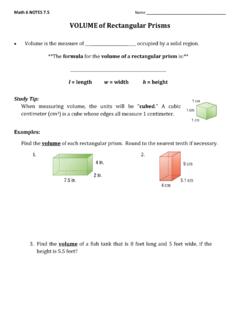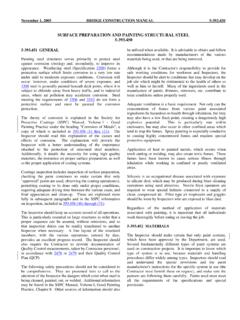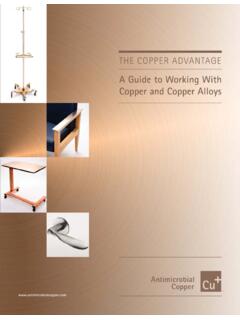Transcription of THE WATER CYCLE - Mustang Public Schools
1 Ecology THE WATER CYCLE WATER is the most abundant substance in living things. The human body, for example, is composed of about 70% WATER , and jellyfish are 95% WATER . WATER participates in many important biochemical mechanisms, including photosynthesis, digestion and cellular respiration. It is also habitat for many species of plants, animals and microorganisms, and it participates in the cycling of all of the materials used by living things. WATER is distributed in the biosphere in a CYCLE known as WATER , or hydrologic CYCLE . Some aspects of this CYCLE are examined in this plate. Let s begin by looking at the atmosphere, which includes the clouds. When WATER vapour cools, it condenses and thanks to gravity it falls to Earth in form of rain, snow or sleet (precipitation over land). Precipitation also occurs over oceans.
2 The living things on Earth are represented, in the diagram, by the trees. WATER is absorbed by their roots and used in photosynthesis, but it is also lost from their leaves through the process of transpiration. WATER also returns to the atmosphere through evaporation from the soil and from numerous other sources. In general, the amount of precipitation received by an area helps determine what types of plants will grow there. The nature of the vegetation, in turn, determines the types of animals that inhabit a region. WATER from the land enters the oceans through seepage from the ground; it percolates from the surface down to the WATER table. This WATER -saturated zone of soil and rock is called an aquifer and WATER seeps from the aquifer to the ocean. WATER also reaches the ocean as runoff from the surface.
3 Runoff from the surface includes flow from rivers as well as melting snowfields and glaciers. The major reservoirs of WATER on Earth are the oceans. Oceans cover about three-quarters of Earth's surface and contain about 97% of its WATER . Solar radiation causes WATER 's evaporation from the ocean. Over 80% of the evaporated WATER in the hydrologic CYCLE enters the atmosphere in this way and about 52% of this falls back into the oceans in the form of rain. The remainder remains in the atmosphere as clouds, ice crystals and WATER vapour and then precipitates over land. On a global scale, the quality of ocean WATER that evaporates each year is equivalent to a layer that's 120 cm deep and covers the entire surface of the ocean. Ecology THE CARBON CYCLE Energy flows from the sun into the biosphere, but nutrients do not enter the biosphere from an outside source.
4 Essentially, the same pool of nutrients has circulates for billions of years that the Earth has been in existence. Some nutrients, called macronutrients, are used by organisms in large quantities, while others, micronutrients, are used in trace quantities. Macronutrients include carbon, hydrogen, oxygen, nitrogen and phosphorus; micronutrients include iodine, iron, zinc and some others. Both macro- and micronutrients are recycled; they are passed back and forth between living and non-living components of ecosystem in processes that we call biochemical cycles. Material substances are incorporated into organic compounds by primary producers. These are then consumed by secondary consumers and decomposers are ultimately responsible for releasing the material back into non-living environment. Let s begin the study of carbon CYCLE with the atmosphere, which is Earth's major reservoir of carbon, in the form of carbon dioxide.
5 Carbon enters the biotic (living) part of the ecosystem through photosynthesis. Plants of the forests take the carbon in carbon dioxide and fix it in organic compound such as sugar, starch, cellulose and other carbohydrates. Respiration in plants returns carbon dioxide to the atmosphere. Plants are primary producers. In the course of plant consumption, carbon passes into primary consumers, animals. When animal consumption occurs or when the primary consumer is eaten, carbon passes to a secondary consumer, represented by a lion. Respiration takes place in cells of primary and secondary consumers and carbon is released back into the environment as carbon dioxide. When the primary and secondary consumers die, their organic matter enters the soil through process of decay. It is broken down by the decomposers or detritus feeder, which are small animals and microorganisms that subsist on decaying matter such as fallen leaves, dead bodies and animal waste.
6 Earthworms, mites, centipedes, insects and crustaceans are detritus feeders. Thus, respiration of detritus feeders also returns carbon to the atmosphere. Through history, much carbon has been converted to fossil fuel. High pressure and temperature transform carbon-containing organic matter into coal, oil and natural gas. Fossil fuel processing follows. There are many uses for fossil fuels. Some power plants generate electricity using fossil fuel and automobiles are power by gasoline. The products of the combustion of fossil fuels include carbon dioxide and other carbon compounds that enter the atmosphere. Carbon also enters the environment from burning of wood and plants that occurs during forest fire. A final aspect of carbon CYCLE is exchange with oceans. Some carbon dioxide from the air dissolves in the ocean and combines with calcium to form calcium carbonate, which is incorporated into the shells of mollusks and other creatures.
7 When these shells decay, they transform into limestone, which over time, dissolves as it is exposed to WATER . Carbon is released from limestone and may return to the atmosphere. Ecology Ecology THE NITROGENE CYCLE An important process in ecosystem is the recycling of nitrogen through its living (biotic) and non-living (abiotic) components. The living components, or biota, of the ecosystem participate in the nitrogen CYCLE in a number of ways. Approximately 78% of the air is composed of diatomic nitrogen. Nitrogen is essential to life because it is a key component of amino acids and nucleic acids. Even ATP, the basic energy currency of living things, contains nitrogen. Neither plants nor animals can obtain nitrogen directly from the atmosphere. Instead, they must depend on a process called nitrogen fixation.
8 Key players in nitrogen fixation are legumes and symbiotic bacteria that are associated with their root nodules. Legumes include clover, peas, alfalfa, soybeans etc. The bacteria associated with their root nodules are nitrogen-fixing bacteria. These bacteria convert nitrogen in the soil to ammonia (NH3), which can be taken up by some plants. The bacteria and the plant are in symbiotic relationship. Cyanobacteria are also nitrogen-fixing bacteria; they are prominent in aquatic ecosystems. Nitrogen is fixed into the soil through the action of free-living bacteria and through bacteria that's associated with root nodules of legumes. Both of these methods of fixing nitrogen lead to its incorporation into ammonia in process known as ammonification. The soil is a major reservoir for ammonia and other nitrogen-containing compounds.
9 After nitrogen has been fixed, other bacteria convert it into nitrate, in a process called nitrification. In the first step of nitrification, Nitrosomonas convert ammonia to nitrite (NO2) and in second step nitrite is converted into nitrate (NO3) by Nitrobacter. The nitrate is then consumed by plants. But not all plants consume nitrate. Some plants are able to use ammonia from the soil. In both cases, nitrogen enters the primary producers in the biotic community. The plants may be then consumed by animals. Herbivores are primary consumers and nitrogen of the plants is used for the synthesis of key organic compounds such as amino acids, proteins and nucleic acids. The final aspect of nitrogen CYCLE is the process of denitrification. This process is performed by a variety of microscopic bacteria, fungi and other organisms.
10 Nitrates in the soil are broken down by these organisms and nitrogen is released into the atmosphere. This completes the nitrogen CYCLE . Ecology THE PHOSPHORUS CYCLE Although nitrogen and carbon exist as gases, certain elements that CYCLE in the biosphere do not exist in gaseous form. These elements accumulate in rocks and soil and participate in what are called biochemical cycles. Among the elements that undergo sedimentary cycles are calcium, sulphur, magnesium and phosphorus, which is one of the key elements in organic matter. Phosphorus is one of the critical elements in biological molecules. For example, it is a component of adenosine triphosphate (ATP) and coenzyme NADP, which are used in important cellular processes such as photosynthesis. Phosphorus is also present in the sugar-phosphate backbone of nucleic acids and is an essential element of phospholipids, which make up the cell membranes.







